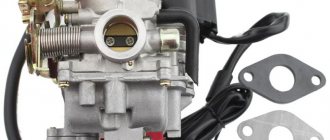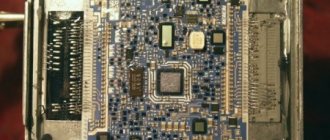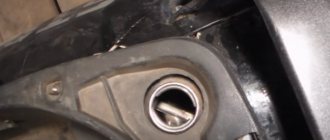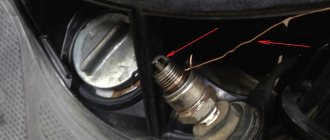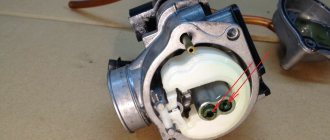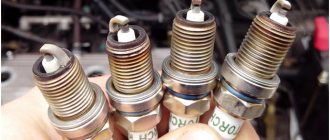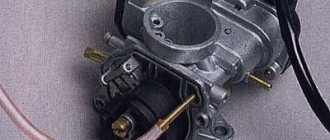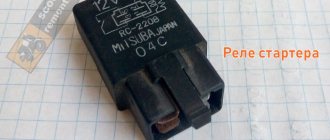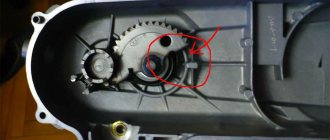Every scooter owner may encounter this problem: a pre-heated engine will work normally, but the scooter will not start in cold weather. Making a launch becomes extremely labor-intensive, or even impossible.
If the scooter doesn’t start well when cold, and you can’t do it with either the kickstarter or the electric starter, then it’s a consequence of problems with the power supply or ignition system. Each malfunction requires special attention, so we advise you to follow the instructions in this article.
Based on the identified problem, troubleshooting a scooter in cold weather takes from a few minutes to a couple of hours.
There is no spark in the spark plug
The moped does not start well when cold due to the lack of a spark in the spark plug. To resolve the problem, you must do the following:
- you need to unscrew the spark plug and visually inspect it for damage, check the electrodes, if they are damaged, the spark plug needs to be replaced. If the spark plug gets wet, remove it from the cap and dry it, then close it back into the cap and watch for a spark. There are 5 possible states of the spark plug: good, wet, contaminated with soot, overheated, contaminated with oil;
- connect it to the ignition coil using a wire and place it on the cylinder;
- When rotating the crankshaft using an electric starter or kick starter, test the spark on the spark plug. Remember that you need to start the ignition on the moped and be careful when testing the spark, it is not recommended to do this with bare hands, protect yourself with rubber gloves;
- during rapid cranking of the crankshaft, a continuous and strong blue spark should appear in the candle; if its color is yellow, or it appears very weakly and every once in a while, then replace the spark plug and test a new one;
Other possible reasons for the lack of spark after inspecting the spark plug
If your Alpha Moped does not start, find out the possible reasons and further steps to action.
Oxidation of contacts
The appearance of the spark plug may correspond to the norm, but the spark still does not appear, which means that a discharge test needs to be done. If there is no spark again, then test the scooter’s electronics for contact oxidation.
No spark on the wire
This may be a consequence of current leakage phenomenon. It is when a metal part of the moped comes into contact with an exposed high voltage wire. The conductor may have been water, which could have accumulated in the area of exposure during active trips through puddles.
You need to carefully inspect the wires running from the spark plug to the ignition coil, and if you do not find any disconnection or damage, then you can assume a critical breakdown in the ignition system:
- damage to the ignition coil;
- ignition sensor malfunction;
- switch failure;
Each of these parts causes a lack of spark and intermittent operation of the engine, so before you buy anything, find out what exactly is wrong and try to borrow a working part to check from your friend.
For many motorcycles, a malfunction - the scooter does not start well - is detected and corrected immediately in the first stages and the engine starts properly, otherwise you should look for problems further.
Important! It is better to stay as far as possible from the spark plug hole at the top of the cylinder, because fuel may splash out and ignite from that place.
Messages [1 to 20 of 34]
1↑ Topic from Uralchik 09/27/2014 18:27:13
- Uralchik
- Newbie
- Inactive
- Registered: 01-06-2014
- Posts: 22
Topic: It's corny, but Ural won't start
Guys, the story is this: I started it, rode about 500 meters and the motorcycle stopped pulling itself (in a straight line), started shooting and sneezing. Well, you understand. Immediately thinking - sucking air. And sure enough, oil was oozing under the left cylinder head. There was an aluminum gasket, I replaced it with a paronite gasket. I set the valve clearances “by eye”, first setting them to TDC (arrow on the flywheel) and adjusting the left one, and then turning the right cylinder back to TDC. I haven’t come across tuning on two-cylinder ones, so I asked my friends how it was done, and then began to demonstrate. It seems that everything is set as before (the gaps feel the same), but the bastard won’t start! Once it grabbed once, roared at high speeds (for some reason, at high speeds) for about five seconds and died. It never started again, didn't even catch. The spark is excellent on both spark plugs, I didn’t touch the carburetors and ignition, as before the breakdown they were still standing, but before the breakdown the engine was flying, not driving
Tell me where to start poking around to understand what's going on?
Oh, I almost forgot to clarify, the battery is fresh, just from charging, unless the motorcycle was parked in the open air, where did the water get in?
Edited by Uralchik (27-09-2014 18:28:06)
2↑ Reply from RaaF37rus 09/27/2014 19:22:37
- RaaF37rus
- Pro
- Inactive
- Name: Sergey
- From: Ivanovo region. Kamenka village
- Registered: 07/27/2013
- Posts: 568
- Reputation: 66
- Motorcycle: IMZ 8-103-10
Re: It’s corny, but the Ural won’t start
Well, it’s better to set the valves not according to the mark on the flywheel, but “when the intake starts to close, you adjust the exhaust, and when the exhaust starts to open, you adjust the intake.” Couldn’t you turn the camshaft? look.
3↑ Reply from Lerych 09/27/2014 19:47:12
- lerich
- MotoDealer
- Inactive
- Name: Valery
- From: Yaroslavl region
- Registered: 01/18/2012
- Posts: 2,138
- Reputation: 215
- Motorcycle: Ural m66, Riga 22, Java 360, Ural 8.103
Re: It’s corny, but the Ural won’t start
so there could be a bunch of reasons. I didn’t touch the carburetors, but gasoline may not flow. from the same tank for example. I have about the same crap. it started and worked well, and then suddenly it won’t pull after 5 km. I took the carbs apart and gasped! there the dampers are not just worn out, but they are even chewed up, just on the cylinder, which barely plows. The tank was so clogged that I had to pierce the nipples that connect the compartments with a nail. The ignition tends to unscrew. The camshaft support has the same property, but the marks no longer match and the valve timing shifts. The valves are somehow strangely adjusted. As I understand it, if you set it according to the mark, then one cylinder and the second should be set at 180 degrees, and not according to the mark. Otherwise, all strokes will occur on both cylinders at the same moment, and this should not be the case.
- From: Permyak
- Registered: 05/16/2012
- Posts: 6,924
- Reputation: 618
- Motorcycle: Dnepr MT 10-36, Ural M 67
Reasons why the scooter does not start when cold
:is::is::is::is: killed. I won’t say anything further. I’ll just ask a question - uncle, how old are you? and then what the HELL they say to check the compression not hot, not cold! and then when the engine is slightly warmed up. - I’ll answer.
It’s nice when the engine of a four-stroke scooter works “like a clock” and does not cause any trouble to its owner. But basically this only happens when the unit is warm. As soon as the two-wheeled “minibike” sits in the cold for a while, that’s it – there’s no way to start it when it’s cold. And you can't make it purr either from the starter or using the foot. So why does it happen that a four-stroke scooter does not start? The most common problems are in the ignition and fuel supply systems. More on this below.
Diagnosing a candle
The first step is to conduct a visual inspection of the spark plug. Unscrew it and look carefully to see if there are any mechanical damages or defects associated with melting. If any of this is present, then the spark plug should be replaced. In addition, moisture could get on it. To verify this, you need to remove the ignition element from the cap and let it dry. You can even do this over a gas one.
Quite often you can see cases when the owner is faced with the following problem: the scooter will not start. This may be due to a large number of reasons. Most often these are typical breakdowns or malfunctions, especially if the moped was parked in cold weather. Depending on the identified problem, the moped can be repaired in a few minutes or several hours.
Typical reasons
First of all, you need to check: the ignition and power systems. Carry out a check in those places that can cause the moped to move. The reasons why the scooter does not start, especially in cold weather, may be the following:
No spark in spark plug
The scooter does not start because there is no spark in the spark plug. In this case, you need to do the following: the spark plug is unscrewed and checked for suitability. Connects to the ignition coil using a wire.
How to restore starting from the starter
How to start a car with a pushrod
The moped does not start well from the starter, however, doing it from the foot is simple and easy. If the engine does not start well from the starter, you must first check the fuse located in the battery compartment.
The location of the fuse on the battery is marked with an arrow.
Due to the often poor quality of the manufacture of the fuses, and, consequently, the entire starter, the wire located inside the starter glass bulb can barely touch the contact caps, which is why the fuse contact becomes unsuitable. After the low-quality fuse has been replaced, the moped can be started using the starter.
Why the scooter doesn’t start well when cold, let’s figure it out together
For many owners, a four-stroke scooter is a faithful assistant that can be used at any time of the year. Therefore, you can often encounter a problem when the scooter does not start well when cold or does not want to start in winter. This is due to a number of reasons that can be eliminated on your own. Most often, the problem lies in the ignition system, the power supply system may be malfunctioning, and air leaks cannot be ruled out, but this problem occurs somewhat less frequently. From this article you will learn how to identify and solve the problem, make the scooter start immediately and in any weather.
Typical reasons
Starting a scooter in cold weather may not always be possible due to various factors. First of all, you shouldn’t torture the equipment if it doesn’t start right away. Check the following:
- Battery condition. If its charge is less than 12 A, the starter will not work. The normal voltage should be 14.5, this can be checked using a voltmeter. Try kickstarting the scooter.
- No spark. If the scooter was working fine, but then stopped starting, you should check to see if there is a spark. To do this, you need to pull out the spark plug and check its condition. The problem could also be with the coil or switch.
- The equipment may not be satisfied with the quality of gasoline.
- The malfunction may be hidden in the power system. If the scooter has trouble starting when cold, try adjusting the carburetor.
This is interesting: Penalty for crossing the stop line
Malfunctions in the power system
The power system may be to blame; If the piston group of the engine is working properly, then you should check whether gasoline enters the combustion chamber or not. This is easy to check: unscrew the spark plug and inspect it; if it is wet, it means gasoline is flowing. If it’s dry, we start checking with the gas tank: first, you need to find out if there is gasoline in there. If there is, check whether the tap is open. If everything is open, you need to remove the vacuum hose and clean it with air.
If everything is in order, move on to the carburetor float chamber. The bottom of the device is removed; it is usually held on by bolts. It contains a float. If the chamber is full, but gasoline does not flow to the cylinder, the nozzle is most likely clogged. You will need to pull out the needle, remove debris, dust, and all foreign particles. You can also check the scooter's petal valve: it is located below the carburetor. The petals may be damaged, causing the scooter to not start even if it is new. If the petals are not closed tightly enough, the valve must be replaced. In some cases, you can bend the petals with your fingers, but this measure will only help for a short time - only to start the scooter several times and ride it for parts.
In case of serious damage, you should check the piston, whether it gives the required compression ratio, the seals of the piston system, the CPG and the ignition system. But these reasons are more likely characteristic of old equipment that was not properly cared for.
No spark in spark plug
First of all, you should check the spark plugs if the moped does not want to start.
- The spark plug needs to be unscrewed. You can check it using a special device that is sold in car dealerships; it's inexpensive. You can inspect the candle visually. It should not be black or damaged.
- If the candle is wet, it needs to be dried. This should not be done with open fire.
- The candle may be stained with oil and carbon deposits may be visible on it. All this is cleaned with metal brushes, similar to toothbrushes.
- An easy way to check if there is a spark is by unscrewing the spark plug, putting the wire on it leading to the ignition coil and placing it on the cylinder. If you turn the starter, you will see a spark. If the spark plug is working but there is no spark, the problem is in the ignition coil.
Attention! The procedure must be carried out carefully, without touching the scooter frame or other metal objects with your bare hands, otherwise you will get an electric shock.
If there is a spark and its color is yellow, then you need to install a new spark plug; yours is no longer suitable for use. A normal spark is blue and flows continuously.
If the coil is new, as are the spark plugs, but there is no spark, it is still worth checking the following:
- Oxidation of electrical wire contacts. They will need to be cleaned; for example, the wires going to the battery often become oxidized.
- No spark on the wire. This means that somewhere there is a bare wire that touches an ungrounded metal part, because of this the spark does not appear, since the current does not reach the coil. Check the wiring.
- The switch may also fail. This is an inexpensive item that it doesn’t hurt to always have in reserve.
Checking Basic Systems
In order to understand why the scooter does not start, the problem must be looked for sequentially:
- Start with the simplest thing - check the battery charge, if it is normal, proceed further.
- Check if the scooter has gas; it’s easy to forget to fill up.
- See if gasoline is flowing into the carburetor.
- Unscrew the spark plug, inspect it and check if there is a spark.
- If the spark plug is in order, check the coil in the manner described above, turning the starter with the spark plug removed.
- We check the coil and wiring with a multimeter, there may be a break.
- Clean the carburetor and adjust it correctly.
Supply system
After checking the electrics and making sure that everything is in order, you should get to the power system: if the fuel is supplied in the wrong amount, the scooter may not start. If there is a large amount of fuel, the carburetor overflows and the spark plug becomes wet, and if there is little fuel, there is not enough of it for the piston to move. To do this, you need to adjust the jet, floats and needle, moving the limiter on it. It wouldn't hurt to check the gasoline pump either: sometimes it simply fails, so the fuel doesn't go anywhere.
Ignition system
The entire ignition system must be checked if there was a spark and then disappeared. If the spark plug and coil are normal, but there is still no spark, you will have to check more thoroughly. The coil, generator winding, and switch come under suspicion. A multimeter can check all this: for example, they test a generator like this - one probe is connected to the engine crankcase, the second to the generator sensor.
The resistance of a working sensor is 500 Ohms. If the value is higher, the winding is faulty; if it is below 200 Ohms, the problem is in the coil.
The spark plug is faulty, the gap is incorrectly set, or the electrodes are covered with a black velvety coating
The next step is to check the spark plug. Of course, the glow number and rating of the spark plug should be as recommended by the scooter manufacturer. You should not use the first candle you find in the garage.
Now check the electrodes. They should be clean, without black velvety deposits, brick-colored.
The spark plug gap should be in the range – 0.6 – 0.8 mm.
At the slightest contamination, the spark plug must be cleaned and the gap checked again.
The presence of black carbon deposits in this case also indicates that the engine is running on a rich mixture, which means that the carburetor should be adjusted.
A cold scooter (moped) engine does not start - looking for the reason
You can often encounter a situation where a warm scooter engine works fine, but when it’s cold, problems arise and starting it becomes extremely difficult, and in some cases, impossible. However, you will not be able to start the scooter using either an electric starter or a kickstarter.
In this case, the problem usually lies in the ignition system or in the power system. Both breakdowns require serious attention and adherence to clear instructions, which I will describe below.
Since most often the problem lies in the ignition system, we will consider this point in more detail. After that, let's move on to the power system.
The scooter does not start due to problems in the ignition system.
To begin with, we unscrew the spark plug and examine the electrodes; if they are melted or have any defects, we replace the spark plug with a new one.
If the candle is wet, be sure to remove it from the cap and dry it, for example, I do this on a gas stove. Now insert it back into the cap and check for a spark.
How to check for a spark on a scooter, the scooter will not start due to problems with the spark plugs
To do this, you need to place a spark plug on an unpainted part of the engine, usually the cylinder, and crank the crankshaft using an electric starter or kick. Before doing this, do not forget to turn on the ignition of the scooter. You should not check the spark with your bare hands; you should definitely protect yourself with special thick rubber gloves or a piece of rubber.
Another point to consider is that the spark plug must be kept away from the spark plug hole in the cylinder head, as gasoline may splash out from there and ignite. This has not happened in my practice, but the recommendations should not be neglected.
When the crankshaft is cranked sharply, a blue spark should run through the spark plug, quite powerful and constant. If there is no spark, or it is yellow and appears occasionally, first of all, we take it as faulty and check the spark in the same way on a new spark plug. As a rule, in more than half of the cases, at this stage the problem is solved and the scooter works properly. That is why it is so important to always have a working spare spark plug with you, which will always save you on the road in such a situation.
If, after you installed a new spark plug, the problem remains, we look for a known faulty place further:
The scooter will not start due to a faulty spark plug cap or connection to it.
It also happens that the cap may not be in sufficiently tight contact with the high-voltage wire. To exclude this from the possible causes of the malfunction, we must check it. We unscrew the cap from the wire and bring the wire 2-3 mm to the metal part of the engine. Please note that if, in the case of a spark plug, we pressed it against the engine, then in this case the specified distance must be maintained.
Crank the crankshaft and pay attention to the end of the wire; a spark should jump between it and the engine (do not forget that we do all this with the ignition on). If a spark appears, you can breathe a sigh of relief. We examine the spark plug cap, if it is wet (and often because of this the normal spark disappears), then we dry it with a hairdryer, replace the spark plug and check the spark. No changes? Then we replace the cap with a new one and go.
Now consider the option in which there is no spark even on the wire .
This phenomenon can occur due to the so-called current leakage. The essence of this phenomenon is that any exposed section of the high-voltage wire touches the metal part of the scooter. This may not happen directly, and the role of a conductor can be played by water that accumulates in the area of the bare area when driving through puddles.
Examine carefully the wire running from the spark plug to the ignition coil; if you do not find any disconnections or damage, then you can assume more serious damage to the ignition system, namely:
- the ignition coil has failed;
- the ignition sensor (hall sensor) has failed;
- the switch is faulty;
This is interesting: How to buy a used car and not make a mistake in choosing
Any of these elements, if faulty, can cause a lack of spark or unstable operation of the scooter engine. You shouldn’t buy them right away; it’s important to determine which electrical appliance is faulty. To do this, for example, you can borrow exactly the same one from a friend for testing.
The scooter does not start due to problems in the power system.
You should pay attention to this point first of all if you have a spark on your scooter and there are no problems in the ignition system.
Difficulty starting the engine, if considered only within the framework of the power system, will arise either from a lack of fuel or from its excess.
On older mopeds, such as “Karpaty” and others, the fuel tap is installed immediately at the bottom of the tank. Disconnect the hose from the carburetor and open the tap; if gasoline begins to flow out of the hose, skip this step and turn all your attention to the carburetor. If gasoline does not flow, although there is some in the tank, then the problem is either in the tap itself or in the line, we’ll take a look and see.
Modern scooters and mopeds have an automatic fuel tap, which operates due to vacuum. A striking example of such scooters are Yamaha and Suzuki equipment, as well as similar Chinese scooters. Here the gas tank is installed above the carburetor, and the role of the tap is performed by a small membrane-based device. Sometimes it is this membrane that can fail due to contamination and other factors. This type of fuel tap cannot be repaired, and if it fails, it must be replaced.
On Honda scooters, generally, the gas tank is located below the carburetor, and fuel is supplied to it by a fuel pump. In this case, of course, the above fuel taps are absent, since they are simply not necessary. It is very simple to check the operation of the fuel pump, disconnect the gasoline supply hose to the carburetor and pump the crankshaft with a kick or electric starter, the gas pump should produce fuel and gasoline will begin to pour out of the hose.
Since we are considering problems with starting the engine of a scooter and moped “in the cold”, and the starting enrichment is responsible for this start, you should definitely check it too. To briefly describe the operation of the enricher, the essence is that a cold engine requires more fuel to start and operate stable. This is precisely the function that the starting enrichment performs. A special needle opens an additional channel and slightly more fuel enters the carburetor than usual. Initially, the needle is in the retracted position. Inside the starting enricher there is a heat element, which, when heated, pushes out the needle and closes the channel.
If the starting enrichment is faulty, then enough fuel for normal starting does not flow into the carburetor, and of course starting problems arise. To check the enricher, remove it and connect it to a 12V voltage; after some time, the needle should smoothly come out of the body a few millimeters; if this does not happen, it is faulty.
If all the channels are clean and there are no problems in the fuel tap, as well as in the fuel pump and enricher, we proceed to disassembling the carburetor and thoroughly washing it. How to do this has already been described in previous articles.
It should be noted that difficulties with starting a cold engine also arise when the piston is worn out, so in this case it would be a good idea to check the compression, especially if your scooter or moped has traveled more than one thousand kilometers.
If you have difficulty starting the engine, and all the above remedies did not help you, ask a question in the comments field, and we will try to solve the problem together. Good luck with the repair.
You can also read other articles on the topic:
